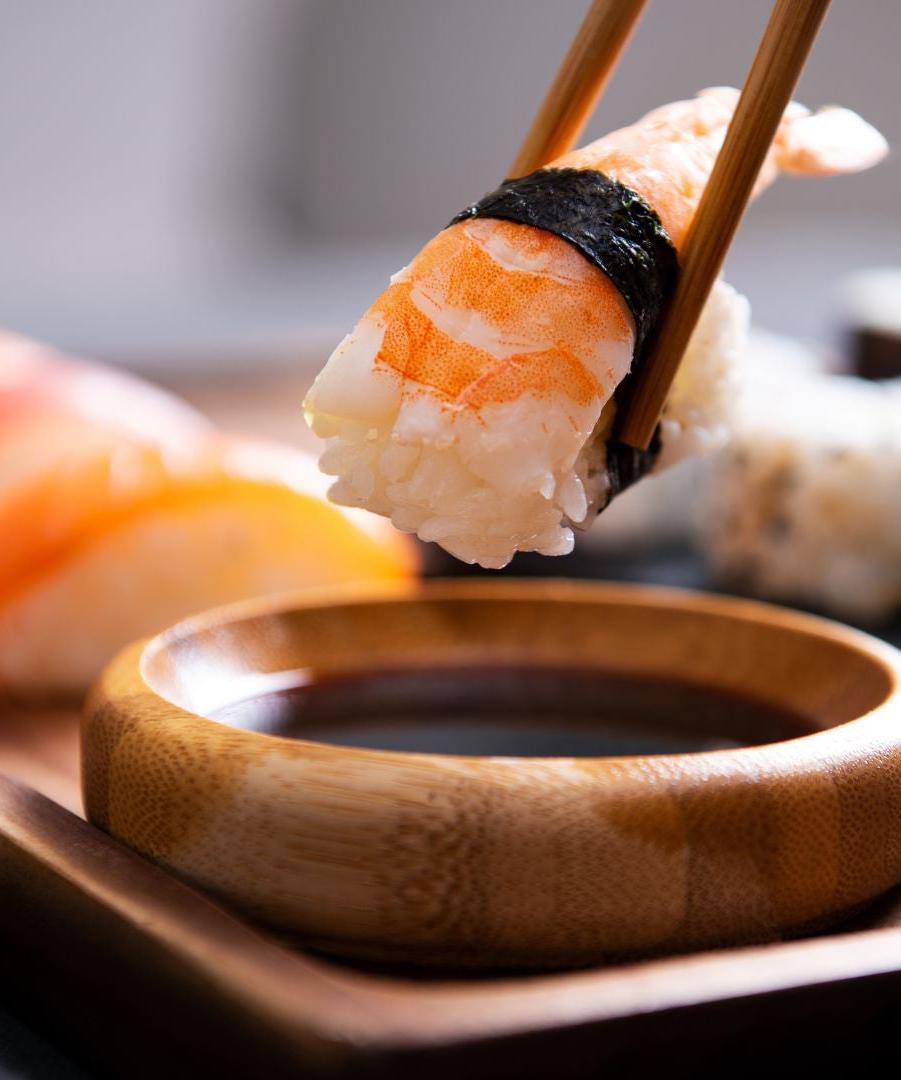


Соевый соус с низким содержанием натрия позволяет придать блюдам насыщенный вкус, контролируя потребление натрия. С его помощью можно улучшить вкус любимых блюд и открыть для себя новые рецепты, которые помогут вам поддерживать здоровье. Попробуйте добавлять его в простые блюда, приготовленные в воке, или использовать в качестве соуса. Не стесняйтесь экспериментировать и найдите то, что подходит именно вам.
Соевый соус с низким содержанием натрия Это вкусный вариант для вашей кухни. Вы получаете тот же насыщенный аромат и пикантный вкус, что и обычный соевый соус, но с гораздо меньшим содержанием соли. Производители производят соевый соус с низким содержанием натрия, сначала вываривая обычный соевый соус. Затем они используют процесс опреснения для снижения содержания соли, чтобы вы могли наслаждаться классическим вкусом умами без лишнего натрия.
Если вы хотите готовить более здоровую пищу, в большинстве рецептов можно заменить обычный соевый соус на соевый с пониженным содержанием натрия. Вы всё равно сохраните насыщенные, пикантные нотки, которые делают азиатские блюда такими вкусными.
Выбирая Безглютеновый соевый соус с низким содержанием соли помогает контролировать потребление натрия. Многие люди ищут способы снизить потребление соли, особенно если следят за своим артериальным давлением или здоровьем сердца. Обычный светлый соевый соус может содержать от 900 до 1200 мг натрия на столовую ложку. Соевый соус с низким содержанием натрия содержит на 25–50% меньше натрия, что делает его разумным выбором для тех, кто заботится о здоровье.
Соевый соус с низким содержанием натрия позволяет наслаждаться яркими вкусами и поддерживать здоровье. Вы можете смело использовать его в повседневной кулинарии, независимо от того, придерживаетесь ли вы веганского образа жизни или просто хотите сделать более правильный выбор для своей семьи.

Соевый соус с низким содержанием натрия можно использовать во многих повседневных блюдах, чтобы усилить вкус без чрезмерного добавления соли. Этот соус хорошо подходит как для азиатской, так и для неазиатской кухни. Добавьте немного в утреннюю яичницу-болтунью или полейте им тушеные овощи для пикантности. Многие домашние кулинары добавляют его в супы, рагу и даже в чили для усиления вкуса умами.
Вот некоторые популярные блюда, для которых полезен соевый соус с низким содержанием натрия:
Маленькая бутылка Соевый соус с меньшим содержанием соли 150 мл Хранится долго, потому что вкус насыщенный. Достаточно совсем немного, чтобы ваши блюда стали намного вкуснее.
В большинстве рецептов обычный соевый соус можно легко заменить соевым соусом с пониженным содержанием натрия. Для небольших порций используйте столько же, сколько и обычного соевого соуса. Если рецепт требует большого количества, начните с половины количества соевого соуса с пониженным содержанием натрия. Попробуйте блюдо и при необходимости добавьте ещё. Этот метод помогает контролировать солёность и не перебить другие вкусы.
Если вам нужна замена соевому соусу с низким содержанием натрия, попробуйте смешать немного соуса терияки с низким содержанием натрия с водой или фруктовым соком. Эта смесь хорошо подходит для маринадов и заправок, когда вам нужен более мягкий вкус.
Соевый соус с низким содержанием натрия идеально подходит для маринадов, жареных блюд и соусов. Для достижения наилучших результатов предварительно смешайте соус перед приготовлением. Это обеспечит сбалансированный вкус в каждом кусочке. При приготовлении маринада смешайте соевый соус с низким содержанием натрия с рисовым уксусом, небольшим количеством мёда или сахара и небольшим количеством масла чили для остроты. Добавьте свежий чеснок и имбирь для более насыщенного вкуса.
При приготовлении блюд в горячем масле сначала обжарьте чеснок и имбирь в течение примерно 30 секунд. Добавьте соевый соус с низким содержанием натрия и уксус, когда овощи будут наполовину готовы. Это время поможет вкусам смешаться, не теряя при этом свежести. В конце приготовления сбрызните кунжутным маслом и посыпьте свежей зеленью.
При приготовлении соусов помните, что даже небольшое количество соуса может многое изменить. Стремитесь к глянцевой корочке на блюде, а не к жидкой консистенции. Вы можете сбалансировать основные вкусы соусов, следуя этим шагам:
Вы можете раскрыть новые грани вкуса, сочетая соевый соус с низким содержанием натрия с кислотами, травами и специями. Кислоты, такие как уксус или фруктовый сок, придают блюдам яркость и уравновешивают пикантные нотки соевого соуса. Смешивая соевый соус с низким содержанием натрия с ананасовым соком, вы получаете сладкий, терпкий и слегка солоноватый вкус, который кажется более насыщенным, чем при использовании одного соевого соуса. Такое сочетание также помогает снизить общее содержание натрия в вашем блюде.
Свежие травы, такие как кинза, базилик или зелёный лук, придают блюдам свежесть и многогранность. Специи, такие как имбирь, чеснок или хлопья чили, придают блюду теплоту и глубину. Вы также можете использовать смеси трав вместо соли, чтобы добавить вкуса и полезных питательных веществ. Ваши вкусовые рецепторы адаптируются к более низкому содержанию натрия, поэтому вы по-прежнему сможете наслаждаться яркими вкусами.
Вы можете усилить вкус умами в своих блюдах, используя соевый соус с низким содержанием натрия креативно. Научные исследования показывают, что инновационные подходы к рецептуре, такие как использование специальных эмульсий, помогают соевому соусу с низким содержанием натрия сохранять и даже усиливать ощущение солёности. Это означает, что вы получаете ту же глубину вкуса, что и обычный соевый соус, делая ваши блюда такими же вкусными.
Если вы хотите поэкспериментировать, попробуйте использовать соевый соус с низким содержанием натрия в рецептах, где требуется много приправ. Его можно смешать с грибным соусом или каплей томатного сока, чтобы придать блюду ещё больше умами. Травы и специи также помогают сделать вкус более насыщенным, так что вам не будет хватать соли.
То, как вы используете соевый соус с низким содержанием натрия во время приготовления, влияет как на вкус, так и на текстуру. Лёгкий соевый соус имеет жидкую консистенцию, что делает его идеальным для маринадов и заправок. Он образует тонкую плёнку вокруг ингредиентов, помогая им впитать вкус, не становясь тяжёлыми и размокшими. Добавляя соевый соус в правильное время, вы можете улучшить как вкус, так и текстуру блюда.
Если вы хотите отрегулировать солёность, можно добавить в соевый соус небольшое количество соли с низким содержанием натрия. Этот метод позволяет усилить вкус, сохраняя при этом низкий уровень натрия. Травы, специи и кислоты также помогут вам сохранить сбалансированный вкус без использования традиционной соли.
| Способ приготовления | Когда добавлять соевый соус | Полученный вкус/текстура |
| Маринад | Рано | Глубокий, хорошо усваиваемый вкус |
| Жарить в раскаленном масле | Мидуэй | Яркие, хрустящие овощи |
| Суп/рагу | Ближе к концу | Свежий аромат, насыщенный умами |
Вы можете создавать сбалансированные блюда, сочетая полезный веганский соевый соус с другими ингредиентами с низким содержанием натрия. Такой подход поможет вам наслаждаться яркими вкусами, контролируя потребление натрия. Готовя дома, вы контролируете состав продуктов. Вы можете использовать свежие овощи, цельнозерновые продукты и растительные белки, чтобы создать питательное блюдо. Попробуйте добавлять в свои блюда следующие ингредиенты:
Приготовление блюд с использованием этих продуктов и полезного веганского соевого соуса позволяет снизить потребление натрия, содержащегося в добавках и консервантах. Вы также увеличиваете потребление клетчатки, витаминов и минералов. Соевые продукты содержат полезные для сердца полиненасыщенные жиры и белки, что делает их отличным дополнением к растительной диете.
Вы можете сделать свои блюда более полезными, следуя простым советам. Выбирайте соевый соус с низким содержанием натрия, чтобы усилить вкус без чрезмерного добавления соли. Используйте травы, специи и кислоты, например, сок лимона или лайма, чтобы придать блюдам яркость. Диетологи рекомендуют использовать альтернативные варианты, такие как аминокислоты Брэгга, для более насыщенного вкуса с меньшим содержанием натрия.
Приготовление пищи дома даёт вам возможность контролировать содержание натрия. Вы можете увидеть реальные результаты снижения содержания натрия, используя соевый соус с низким содержанием натрия. Например:
| Тип блюда | Снижение содержания натрия (%) |
| Заправка для салата | 50% |
| Томатный суп | 17% |
| Жареная свинина | 29% |
Правильное хранение сохраняет свежесть и аромат вашего полезного веганского соевого соуса. После вскрытия поместите бутылку в холодильник. Низкая температура замедляет окисление, что способствует сохранению вкуса и цвета. Это особенно важно для натурально сваренных и низконатриевых смесей. В холодильнике соевый соус может оставаться свежим от 6 месяцев до 2-3 лет, но для достижения наилучшего вкуса старайтесь использовать его в течение 6-12 месяцев. Всегда проверяйте этикетку на предмет условий хранения и сроков годности.
Сочетая ингредиенты с низким содержанием натрия, следуя полезным советам по приготовлению пищи и правильно храня соевый соус, вы сможете наслаждаться вкусными, сбалансированными веганскими блюдами каждый день.
Вы можете сделать свои блюда более полезными и вкусными, выбрав соевый соус с низким содержанием соли. Этот универсальный ингредиент подходит для жареных блюд, супов, маринадов и соусов. Попробуйте эти практичные советы, чтобы получить максимум удовольствия от готовки:
Экспериментируйте с новыми вкусовыми сочетаниями и наслаждайтесь преимуществами пониженного содержания натрия в вашем ежедневном рационе. Вы делаете шаг к лучшему здоровью каждый раз, когда делаете осознанный и вкусный выбор.
Hi! Click one of our members below to chat on